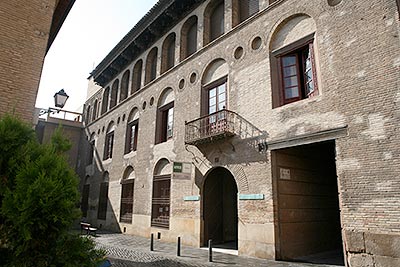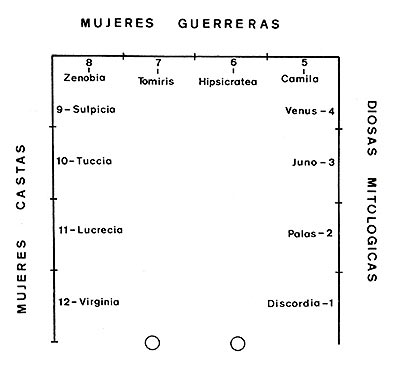BRINGING HERITAGE CLOSER. TUDELA
3 September 2008
Illustrious women of the Renaissance in the Magallón Palace
Ms. María Concepción García Gainza. Chair of Navarrese Heritage and Art.
The group of mural paintings and humanistic content that decorates the staircase of the Palacio de los Magallón or of the Marquis of San Adrián de Tudela, is a program of great originality within the art of the Hispanic XVI century. In the Renaissance, both Italian and Spanish, there were abundant programs of illustrious men that adorned the halls and courtyards of Renaissance palaces. These men were shown as model to be painted. On the other hand, sets of illustrious women are less frequent and certainly not as complete as the Tudela palace sample.

Façade of the Palace of the Marquis of San Adrián
The complex is in a palatial context, which corresponds to the construction methods typical of the Ebro Valley, propagated in the middle of the 16th century by masters from Zaragoza, who moved their activity to Tarazona. In the last two decades of the 15th century, the purchase of a house near the primitive palace is documented with a view to enlarging it. In 1512 possession was taken of "de las casas de los Magallones" and in 1525 work was done on the foundations. A testimony of the notary Pedro de Almoravid on June 3, 1552 gives news "of the permission given to Don Pedro de Magallón so that he could continue the work he had begun on the main houses on the main street leave towards San Francisco of the parish of San Julián". The work continued in 1553 and must have been finished, at least with regard to the façade, in 1556. From then on, specifically in the 60's, the construction of the patio, staircase and decoration, all during the lifetime of Don Pedro de Magallón, of whom we only know that he was married to Laura de Soria and that he made a will in 1592. The paintings would be dated in the last years of the decade of the 60's, between 1568-70.

Detail of the staircase of the Palace of the Marquis of San Adrián
The group of paintings occupies the upper part of the three panels of the stairwell, distributed in four semicircular niches on each side, separated by a mock architecture based on fluted columns and frieze of fruits, masks, dragonflies, hermes and other motifs. Under the arches are represented a group of 12 famous women whose lives are shown as exemplary as a mirror in which to be reflected. They are grisaille paintings executed with the oil technique. The identification of each one of them has been achieved thanks to the Latin texts that illustrate the life of each one of these famous women and goddesses that highlight their virtues: courage, modesty, chastity, wealth, intelligence or beauty, showing them as an example. The texts are written in elegiac distiches. The 12 women have been identified to compose a program on the excellence of women, a thought very much in vogue in the 16th century in all the feminist literature that emerged at the time, a good example of which is Boccaccio's book "De claris mulieribus", which includes more than a hundred women, ranging from Eve, goddesses of mythology, heroines of Greek and Roman antiquity and concludes with Joan, Queen of Naples. Boccaccio's Illustrious Women was printed in Saragossa in 1494. It could undoubtedly have been a textual source , although not a visual one. Regarding textual sources, it should be noted that in the inventory of the library of the Marquis of San Adrian there is a considerable issue of works by classical authors. The author of the program could be Melchor Enrico or Arbolanche of the Estudio de Gramática de Tudela, who mastered mythology. The painter of the set must be the Italian Pietro Morone, a native of Piacenza, who sought visual inspiration in the world of Raphael, which he knew from his stay in Rome.

outline of the arrangement of the illustrious women in the staircase of the Palace of the Marquis of San Adrian

Woman warrior: Zenobia
PROGRAM
TUESDAY, 2 SEPTEMBER
Place: Tudela. Dean's Palace
16.30 h: Opening and presentation of the course
16.45 h. The recovery of the ornamentation of Tudela Cathedral
Ms. Mercedes Jover Hernando. Chair of Navarrese Heritage and Art
17.45 h. Coffee break
18.15 h. Santa María de Tudela and the medieval architecture of the Ebro Valley
Mr. Javier Martinez de Aguirre Aldaz. Complutense University of Madrid
19.15 h. Artistic relations between Aragon and Navarre in the 15th century: the case of Tudela Cathedral
Ms. Carmen Lacarra Ducay. University of Zaragoza
20.15 h. visit guided tour of the cloister of Tudela Cathedral
WEDNESDAY, 3 SEPTEMBER
Place: Tudela. Dean's Palace
16.30 h. Architecture and the city in the 16th century
Ms. María Josefa Tarifa Castilla. Chair of Navarrese Heritage and Art
17.30 h. Coffee break
18.00 h. Illustrious women of the Renaissance in the Magallón palace
Ms. Mª Concepción García Gainza. Chair of Navarrese Heritage and Art
19.00 h. visit to the Magallón palace
THURSDAY, 4 SEPTEMBER
Place: Tudela. Dean's Palace
16.30 h. Art and devotions in Tudela between the 16th and 18th centuries
D. Ricardo Fernández Gracia. Chair of Navarrese Heritage and Art
17.30 h. Coffee break
18.00 h. visit guided tour of the convents of the Company of Mary, Capuchin and Dominican nuns in Tudela
FRIDAY, 5 SEPTEMBER
Place: Tudela. Dean's Palace
16.30 h. Art, report and collective identity: The commemorative monument in the city of Tudela
Mr. José Javier Azanza López. Chair of Navarrese Heritage and Art
17.30 h. Coffee break
18.00 h. Tudela and Navarrese painting from the period between the centuries
D. Ignacio J. Urricelqui. Chair of Navarrese Heritage and Art
19.00 h. The Bardenas and La Mejana. Landscape and still life in Tudela painting
D. Manuel Motilva Albericio. Director of the Muñoz Sola Museum in Tudela.
20.00 h. Closing ceremony
